Goal of an integrated powerplant knowledge platform nearly reached

Twenty-five years ago, at least one powerplant controls company executive articulated a vision of integrating disparate and siloed software applications into a unified whole, anchored by the distributed control system (DCS). That executive was Robert Yeager, long-time president of Emerson’s Power and Water Solutions. At the company’s 2020 virtual Ovation Users’ Group Conference (OUG), it became clear that Yeager is tantalizingly close to achieving that vision.
“We are no longer just a distributed control system company,” Yeager said in his traditional opening remarks. “With the continuous evolution of our Ovation automation platform, we are a protection and condition monitoring, failure prediction, excitation, simulator, advanced monitoring and diagnostics, data analytics, advanced visualization, and a PLC (programmable logic controller) company.” For that matter, today the vision for Ovation platform now encompasses the entire electricity supply and delivery chain (Fig 1), not just the powerplant.
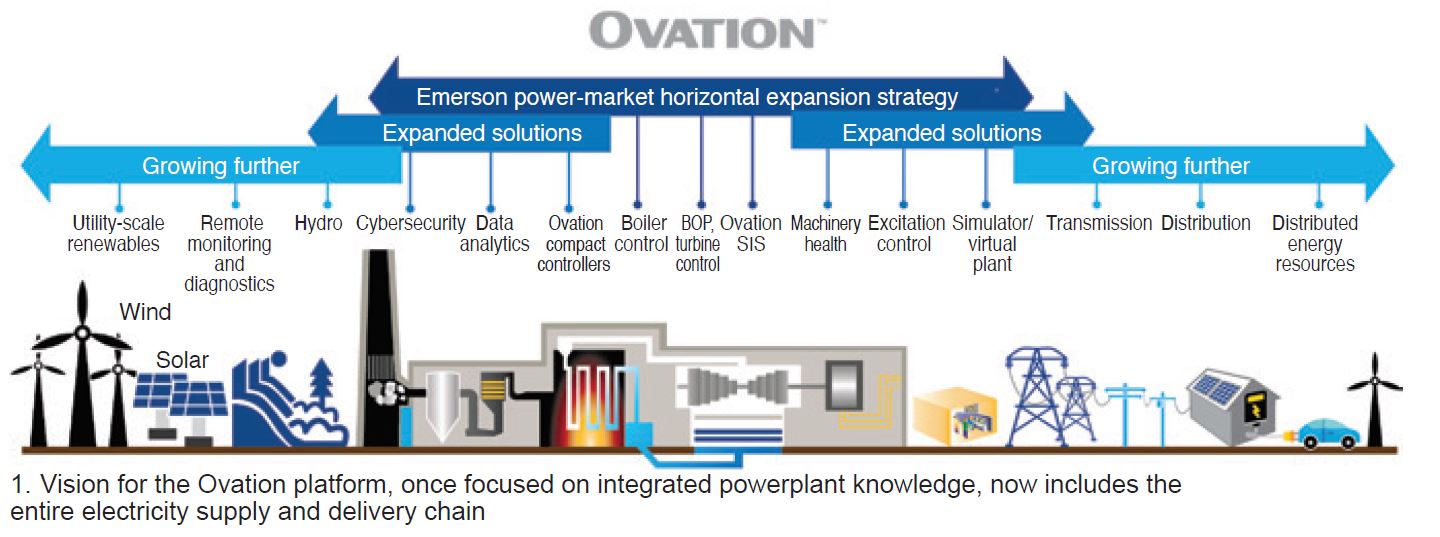
Indeed, not only is the Ovation platform all that, it has also become the gateway for services and expertise provided from, well, anywhere. This capability was certainly stressed-tested in the last few months as Emerson and its customers grappled with a COVID-19 ravaged landscape.
Most digital-system experts would agree that perhaps the greatest threat to Yeager’s vision would be something impossible to envision back in the mid-1990s: cybersecurity. To mitigate that threat, over the past few years, Emerson developed capabilities, native and through strategic partnerships, such that Yeager could also say, “We’re a cybersecurity company.” One that works on other vendor control systems, to boot.
Major OUG themes on Yeager’s mind this year included the following:
-
- Challenges associated with a shift toward renewables and maintaining business continuity during a global pandemic.
- Emerson’s acquisition of American Governor, which brings hundreds of hydroelectric sites into the user fold.
- Expanded relationships with turbine OEMS, such as the recently announced collaboration with Mitsubishi on power industry digital transformation.
- Implementation of IEC 62443, the latest cybersecurity industry standard.
- Expanding the Ovation platform’s footprint to include T&D and distributed energy resources.
- A virtual repair and enhancement center anchored by the “live” version of the Ovation digital twin simulator.
These were expanded on in the follow-on presentations.
Regarding the last and, frankly, profound piece of the puzzle, Yeager encouraged the audience to think of the repair and enhancement center as a “repair shop, saying: “Drive in if you have squeaking brakes, or your check-engine light is on.” As a directly relevant example, Yeager said, “suppose you have too many alarms (or check-engine lights) on, bring your ‘plant’ into the shop, we’ll fix your alarms, and you can upload the changes during your next outage!”
Users catch up to vision
In evidence every year at the OUG, and expected, is that the “facts on the ground,” or “in the field” in this case, are a few years behind Yeager’s vision. One user who commented live on his plant’s experience with the digital twin said it was primarily used for training. “Operators don’t get much opportunity to train on abnormal situations, and the simulator is close to what they would get in a real situation.”
Yeager noted that there are hundreds of digital twins now in service. In a later presentation devoted to technology, VP Software Solutions Rick Kephart said they were working with beta sites now on tools to keep the Ovation simulator up to date with the changes in the actual control system, and that “we are looking at a few pilot projects to achieve the ‘holy grail,’ synchronized simulation,” or an authentic live digital twin.
Necessity is. . .
. . .the mother of implementation, to twist a time-worn phrase to fit the COVID-19 period. The virtual meeting applications, networks, and bandwidth to do things remotely, like Ovation training and factory acceptance tests (FATs), have been available for years. But it took a pandemic to show how ready these capabilities were for not only prime time, but all the time.
Working collaboratively with their customers, the Ovation project team shifted from 5% of FATs being done remotely pre-COVID to over 90% as the virus raged across the country. People familiar with that popular self-help/management book “Who Moved My Cheese?” will recognize the project team’s achievement as akin to moving the state of Wisconsin.
Jaime Foose, director of security solutions and lifecycle services, during the part of the program devoted to services, noted that “educational services have seen a dramatic shift to virtual classes, and yet we’ve managed to maintain a 95% customer satisfaction rate.” The services team experienced a reduction in calls from customers, so Emerson proactively called them to offer assistance.
The digital twin sets the stage for the Ovation platform to provide even more services virtually and remotely. Nevertheless, Glenn Heinl, VP North America lifecycle services, anticipated during the Day 2 Q&A that “[the fall] will be an outage season like Emerson has never seen. Approximately 2500 days of Ovation field services were postponed from the spring outage season to the fall and we’re tapping into all of Emerson’s North America and worldwide resources to provide support.”
Yeager mentioned during the opening that 70% of Ovation’s field engineers are still traveling to sites, “even sites with COVID-infected staff.” More than 2500 onsite service days were provided from March through July. At headquarters, Emerson put a COVID preparedness team in place in early March, with one tactic dividing the HQ staff into A and B teams, with half the staff coming in one week, the other half the next week. Yeager called the onsite customer and Ovation teams “heroes.”
Deck plate solutions
The Power Industry session covered specific solutions important to combined-cycle (CC) plant owner/operators.
Bearings. Jason King, manager of machinery health solutions, revealed embedded condition-monitoring (mostly vibration) features within the Ovation platform that now allow monitoring of bearing alignment, turbine balance, and bearing wear, as well as a specific bearing-rub advisory. Vibration analysis is one of the most effective condition-monitoring technologies available, and automation of analysis for turbomachinery greatly improves return-on-investment by allowing users to plan maintenance in advance, reducing forced outages and O&M spend. These features are now in beta test at one site.
On the screen, as one example, the operator sees a “Q factor” for journal-bearing wear, a Q less than or equal to 4 means wear is not indicated, between 4 and 6 means repair at the next outage, and a value between 6 and 8 means repair now. Conveniently, the monitoring values from the Ovation system can be directly tied into the CMMS (computerized maintenance management system) to automate work flow (Fig 2). “This is just one more step towards the autonomous plant,” King concluded.
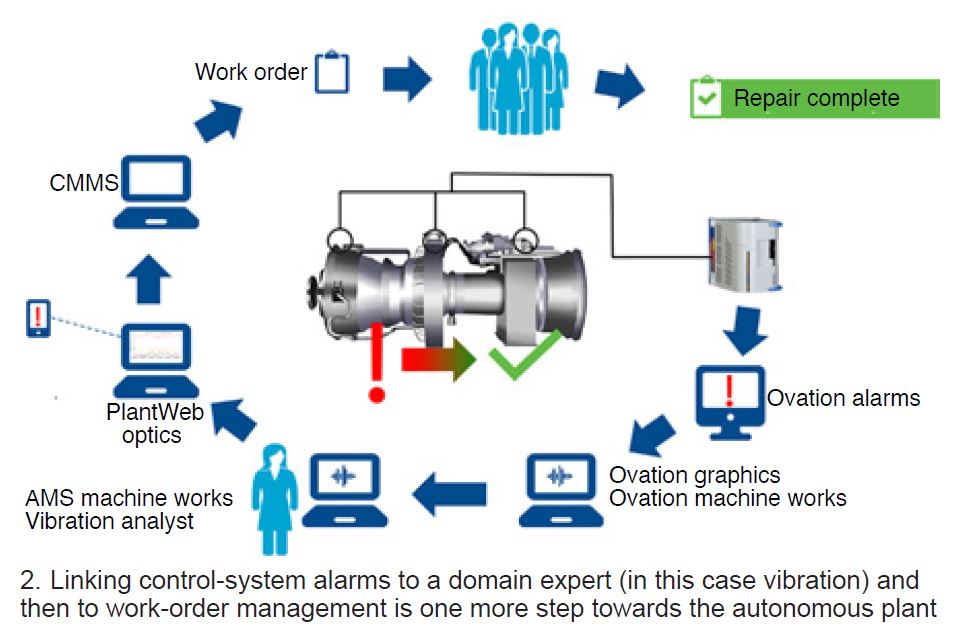
King also introduced features included in the release of the latest version of Emerson’s new advanced vibration analysis software for use with Ovation Machinery Health Monitor, called AMS Machine Works.
Generally, the Ovation Machinery Health Monitor is an eight-channel vibration module compatible with existing field sensors for the steam or gas turbine/generator and other critical rotating equipment.
Steam bypass control. Jim Nyenhuis, manager of performance consulting, covered a solution near and dear to CC owner/operators running high-starts units: steam-turbine bypass control. Specifically, the Ovation platform now includes an advanced bypass-control and steam-temperature application employing model predictive control (MPC) techniques. The actual control-system responses are constantly being compared to the model, and the system automatically adjusts accordingly in real time.
MPC has demonstrated that it can greatly reduce variations in steam-temperature control (Fig 3).
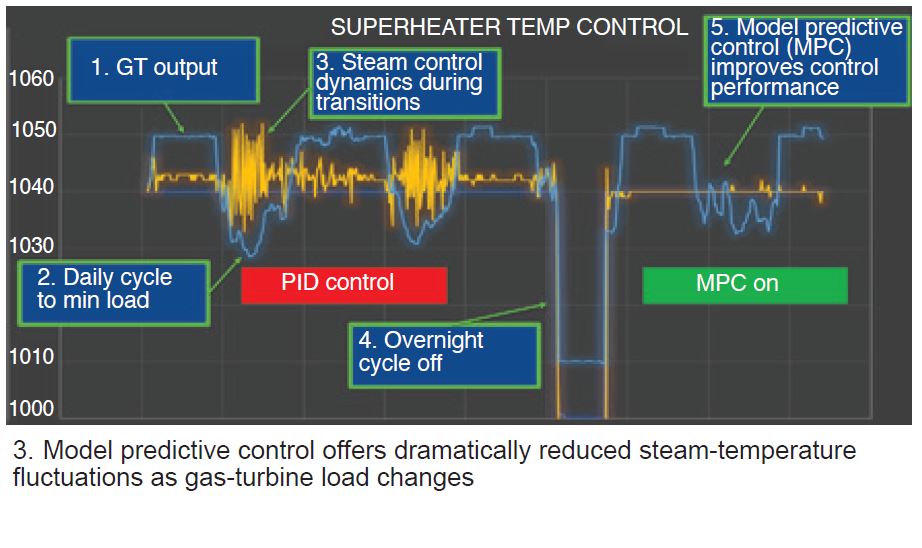
Attemperators have common installation issues, Nyenhuis continued, such as water leakage past the control valve seat, plugged nozzles, improperly sized water droplets, and localized quenching. These problems can be traced back to rapid changes in thermal energy from water injection, but the resulting time lags in energy changes impact the ability of the control system to do a good job.
In many cases, gas-turbine load reductions stress the attemperator, but even at full GT load, the attemperator can cycle between 0 and 30% of capacity if control dynamics are not managed properly. Advanced control often reveals the limitations of bypass control equipment that is improperly sized.
In the real world, operators usually don’t have a good measurement of bypass steam flow. However, by running the live digital twin in lockstep with the plant’s control system together with advanced pattern recognition (APR), the system can provide a “virtual sensor” proxy for steam flow, which in turn can be used in a more robust control strategy.
Faster starts. As gas turbine and CC plant operators respond to renewables, faster starts are necessary to take advantage of new market mechanisms like fast frequency response. Laurence O’Toole, manager of gas turbine solutions, delineated several techniques to achieve faster starts:
-
- Advanced steam-cycle control can minimize mechanical stresses on the HRSG during rapid CC unit startups.
- Logic added to the startup sequence for 7EA machines called fast premix transfer can take full advantage of the purge credit and increase load ramp rates from 4 to about 14 MW/min (Fig 4). Fast premix transfer allows the turbine to fast start by staying in Lean-Lean mode until base load and subsequently transferring to premix mode while at base load.
- Integrating PSM’s Autotune solutions into the Ovation controls, for which testing is now complete, with 10 units expected to be installed over the next year—the first in the US by the end of this year.
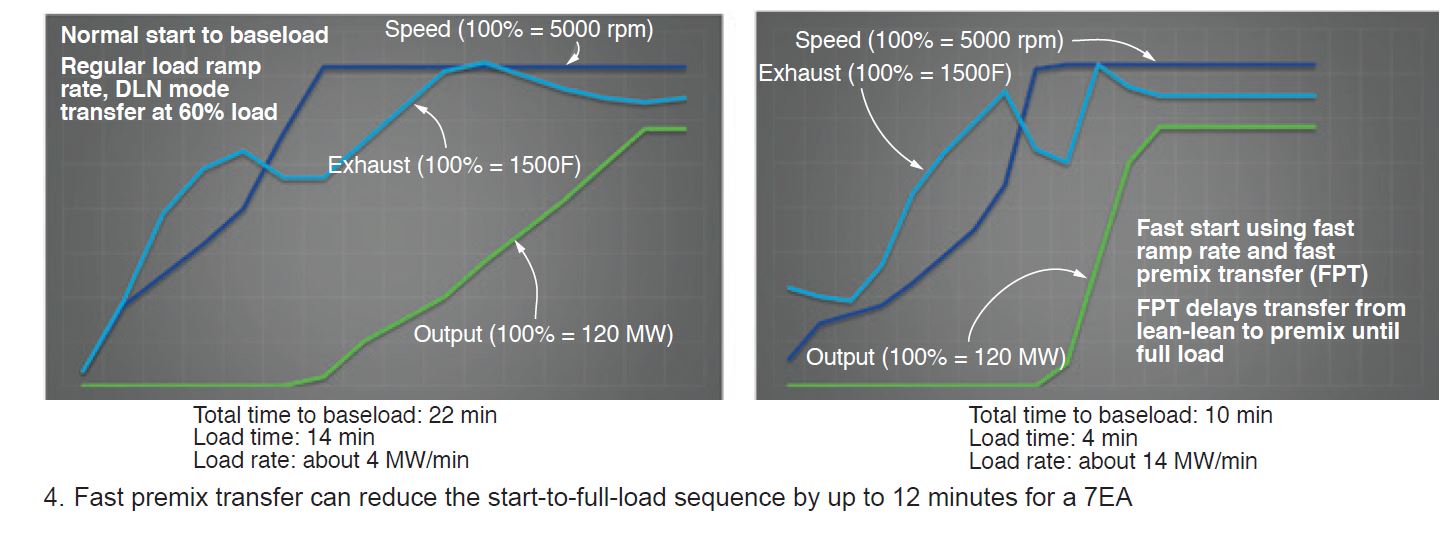
Coming enhancements include an online test for MOD-27 frequency response, the NERC standard ensuring that turbine frequency/MW response is accurately modeled for grid compliance. APR built into Ovation will provide shorter-term equipment trend conditions based on the high-speed data rates available in the platform.
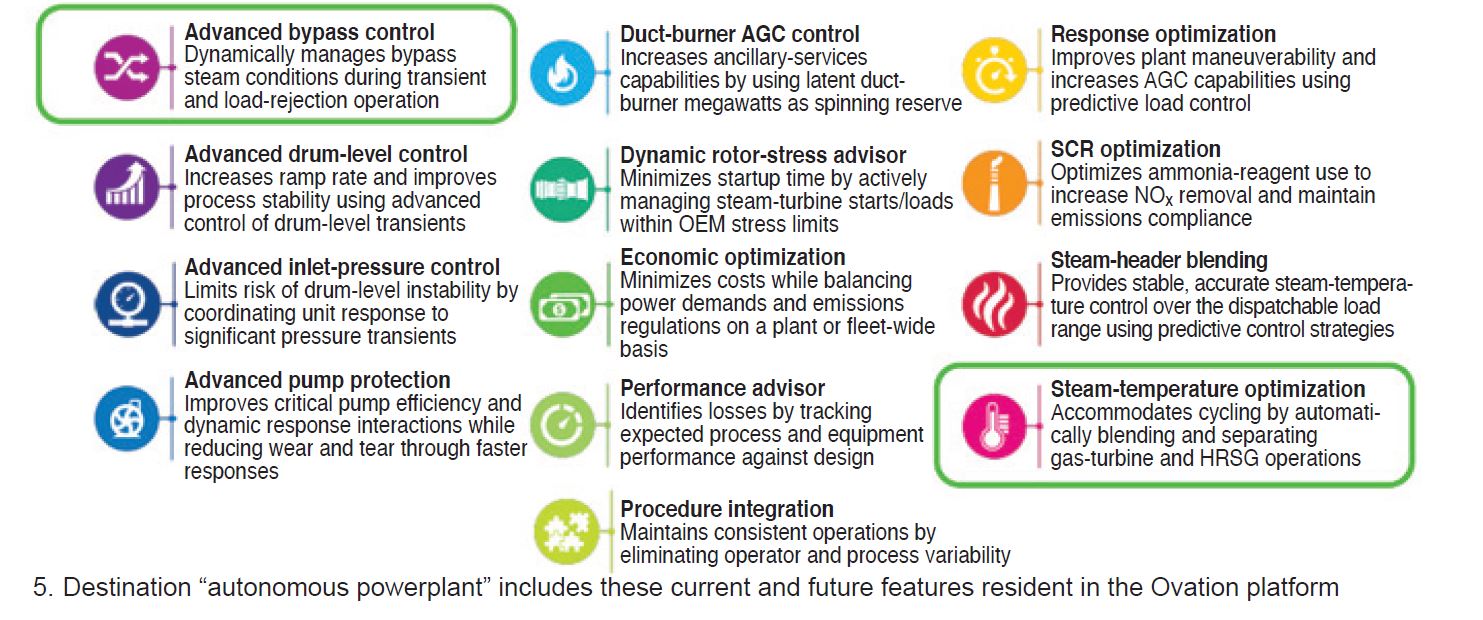
While these three performance goals were the subject of presentations, they are only a few of the advanced power solutions being made available through the Ovation platform (Fig 5).
Ovation Users Group Steering Committee
President, Keith Nelson, Mississippi Power Co
Vice President, Carl Bayley, Xcel Energy
Secretary, Shawn Hawley, Hampton Roads Sanitation District
Outgoing President, John Maloney, Evergy
Bill Collins, Exelon Generation
Joel Erwin, Luminant Engineering Support
Dan Jones, Evergy
Jeff Majka, Metropolitan Water Reclamation District of Greater Chicago
Dave McMullan, Xcel Energy
Daniel Noles, Tennessee Valley Authority
Jim Rarey, American Electric Power Co
Wes Whitley, Alliant Energy
Scott Woodby, Midland Cogeneration Venture
For the Ovation geek
Much of Day 2 of the OUG was devoted to the nuts and bolts of Ovation technology advances, generally the purview of the I&C specialists.
VP Technology Steven Schilling started by reminding the audience that what drives Ovation development are “smaller islands of control over wider geographical areas, larger system capacity, and deploying controllers in remote areas using existing networks.”
Kephart and Roger Hughes, director of global hardware engineering, went deep into the characteristics of Ovation’s scalable controller technology (Fig 6), starting with the OCR1100, a dual-core machine now with 2× to 3× higher processing speed, while maintaining 100% backward compatibility with earlier Ovation versions.
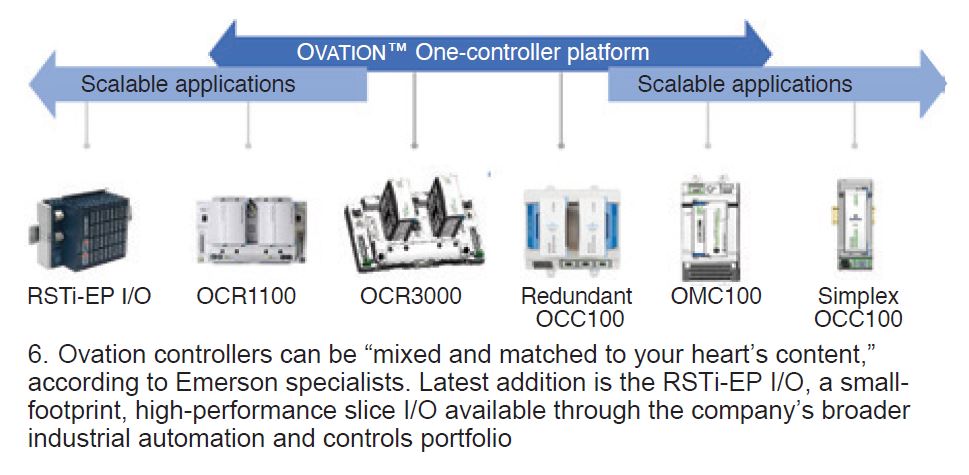
Emerson soon will be introducing the OCR3000, the next generation of its “flagship” controller, according to Kephart. “Both controller families have similar capabilities, but footprint and capacity are the distinguishing features.” Consistency is maintained between the two families of controllers.
The OCR3000 features quad-core technology with 3× to 4× higher processing speeds (depending on the applications running), and network connections available on the backplane to make it “plug and play.”
Ovation also teased its answer to a PLC, a new micro-controller that initiates a secure virtual private network (VPN) between routers, “effectively eliminating separate routers at local remote sites,” according to Kephart, “and reducing the number of moving parts.” Essentially, you get PLC I/O on a DCS platform, he added.
Hughes lauded the very small form factor of the I/O in the controller and noted the flexible user configurable I/O built into the design. Standard Ovation tools familiar for remote I/O are available. For example, Kephart noted that you can plug in a laptop and make changes locally.
The stand-alone version includes what Kephart called “lightweight engineering tools” based on Windows 10, a temporary database server running SQL, and an HMI available locally or from a laptop. Applications are housed in the controller itself.
Moving on to the digital twin, Kephart called it a “mature” and proven product, that now includes integrated simulation with tools that reconcile the Ovation simulator with the production or plant control system without disruption, all “being worked through beta sites right now.” He called synchronized simulation, or live digital twin, the “holy grail” for which Emerson is now evaluating a few pilot projects.
Operator assistance gets really interesting when you combine the live digital twin with the Ovation Process Analytics Studio. Live simulation can be used to locate sensor failures while providing replacement data. “It’s like a modern automobile when the driver swerves into another lane and the control system guides it back. The system can recognize impending equipment failures and respond accordingly, or provide expert guidance about how operators should respond.”
The analytics applications are fed data from the Ovation process historian which incorporates an asset hierarchy replete with failure modes and effects analyses (FMEAs). The controllers are so powerful and fast now that APR functions (also called machine learning technology) can reside on the controller, sort out poor signal quality and bad data, and provide sensor diagnostics. This gives a cleaner, high-speed data set which can be inputted to higher level functions at the M&D center, or used locally.
“Think of it as your iPhone applications,” Kephart suggested, “and the apps don’t even have to be from Emerson” (Fig 7). The practical way to visualize all of this is to realize that all of the functions—such as predictive analytics, thermal performance monitoring, alarm management, and process optimization— hanging off of, say, a siloed data historian in many powerplants, can now be run faster, cleaner, and more secure as part of the Ovation platform.
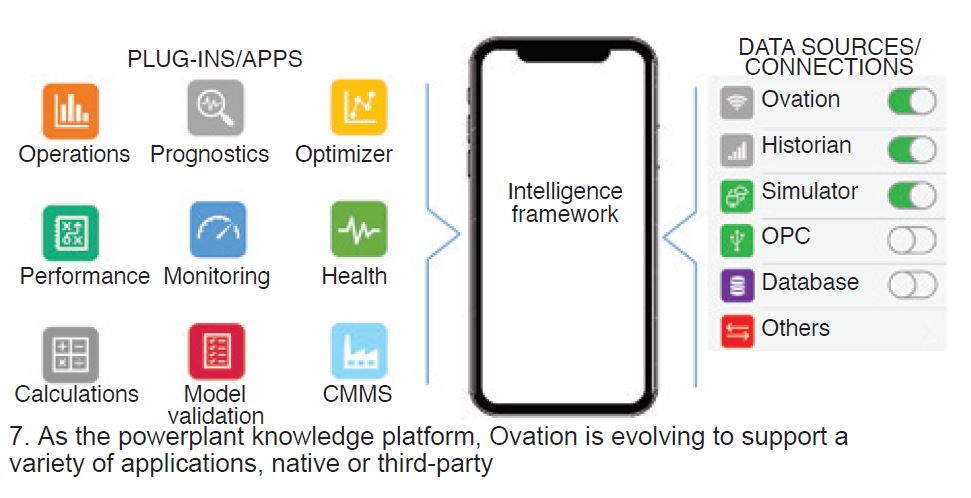
And more plug-in applications are in the pipeline, says Kephart. One example is a performance monitoring tool for control loops. “We can calculate and present a real-time ‘health score’ for each control loop,” Kephart said.
And just to make sure the audience knew it was in Jetsons’ territory, Jaime Foose tantalized the audience with a reference to an augmented reality technology that allows anyone (especially Emerson services staff) to provide direction to the plant through the screen. The technology is now being piloted in the Emerson central service region for external customer support, and is perhaps the finest example of how COVID-19 has forced everyone to reconsider how technology can be harnessed to get work done and keep the lights on during these abnormal times.
Insights from Q&A sessions
After the presentation of the Emerson facility awards (congrats to University of Texas at Austin and its campus microgrid project for winning the innovation award!), Day 3 was devoted to a lengthy Q&A session, with many questions from users unsurprisingly focused on COVID- and cybersecurity-related issues.
One could imagine that the audience breathed a collective sigh of relief when the Emerson team said that there had been no impact on customer support from COVID travel restrictions.
To a question about NERC cybersecurity alerts, the Emerson team responded that they monitor the alerts on a daily basis and respond to customers within 24 hours.
Users also had many questions about controllers, such as: Can the OCR3000 be used in the same network as the OCR1100? Answer: Yes, and also the OCR400; you can mix and match “to your heart’s content.” The flash card in the OCR400 has been replaced with an industrial-grade compact flash storage device, which can be formatted in place. This, to Emerson, is a more reliable solution because you don’t have to remove flash devices.
Two questions on renewables and grid storage systems elicited that Emerson is responding to many inquiries for battery and energy management systems from engineering firms and that H2-based system inquiries are growing. Emerson now has several combined PV solar + battery projects under its belt. Ovation systems now control approximately 3000 MW of solar in North America and Emerson has put in place strategic partnerships to address optimization and obsolescence issues with control systems at legacy wind facilities.
One user asked about lead times to replace old GE excitation systems (in this case, for a 200-MW unit), something clearly on the minds of many in the GT user community, and the answer was lead times vary based on the type of exciter being replaced (whether it is rotating or static), existing space considerations and the bridge size required to meet the generator specific needs.
Finally, responding to a user concerned about the transition from OCR1100 to OCR3000 controllers, Emerson said the upgrade would be straightforward, 100% compatible with existing Ovation hardware and software, and lead to faster processing speeds and lower power consumption. Because the “base is 100% compatible with the old base, it’s basically a swap out.”
Out of adversity. . .
. . .comes opportunity, or so they say. Last year, Jim Nyquist, Emerson’s group president for systems and solutions, opened the OUG by proclaiming this to be “the most challenging environment in history for power and water.” Twenty-twenty has likely eclipsed 2019 in the challenge category, but COVID will undoubtedly prove to be a propellant for achieving, through the Ovation platform, the vision Yeager laid out 25 years ago.





